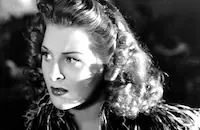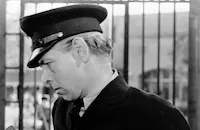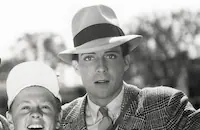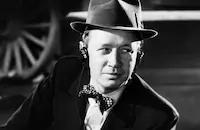The Frozen Ghost
Cast & Crew
Harold Young
Lon Chaney [jr.]
Evelyn Ankers
Milburn Stone
Douglass Dumbrille
Martin Kosleck
Film Details
Technical Specs

Synopsis
During a performance of his popular radio show, Alex Gregor, better known as "Gregor the Great," places his fiancée, Maura Daniel, into a telepathic state under hypnosis. A drunken skeptic in the audience accuses Alex of being a fake, so the angry mentalist begins to hypnotize him, only to have the man drop dead. Although medical examiners state that the alcoholic died of a heart attack, a guilt-ridden Alex proclaims himself a murderer and breaks his engagement. In order to shield the mentalist from adverse publicity, George Keene, Alex's business manager, arranges for his client to go to work for his old friend, Mme. Valerie Monet, as a lecturer at her wax museum. While both Valerie and Nina Coudreau, her niece, are thrilled to have Alex in their museum, Rudi Poldan, a mentally disturbed plastic surgeon who works at the museum as a sculptor, becomes jealous of their attentions toward Alex. Jealousy rears its ugly head when Valerie falsely accuses Alex of romancing her niece. During their ensuing argument, Valerie faints and Alex leaves the museum. Returning the next day with George, Alex learns that Valerie has disappeared and Police Inspector Brant suspects him of her murder. Unknown to all, Rudi has hidden the comatose Valerie among his wax statues. When Nina discovers her aunt, she rushes to Alex's room, and accuses him of plotting against Valerie with the mad surgeon. Unknown to Nina and Alex, Rudi has been conspiring with George to have Alex committed and gain control of his estate. Later, the two meet at the wax museum, where Rudi shows George how he has placed both Valerie and Nina in states of suspended animation. Upon closer examination, however, they discover that Valerie is dead. Now guilty of murder, George insists that they get rid of both women, even though Nina is still alive. Meanwhile, Alex has gone to Maura's apartment to ask for her help, and the two arrive at the wax museum to find a disheveled George. Alex then places Maura into a psychic trance, during which she exposes both George and Rudi. George attempts to escape, only to be captured by an eavesdropping Brant. Alex and Maura then rush down to the furnace room to save Nina. Startled by their appearance, Rudi falls into the furnace and dies. Later, as newlyweds Alex and Maura are about to head off for their honeymoon with their new ward, Nina, Brant arrives and asks for Alex's help in solving a case. Alex replies, "Oh, Inspector, I thought you knew. It's all done with mirrors."

Director
Harold Young
Cast

Lon Chaney [jr.]

Evelyn Ankers

Milburn Stone

Douglass Dumbrille
Martin Kosleck
Elena Verdugo
Tala Birell

Arthur Hohl

Dennis Moore
Leyland Hodgson

Eddie Acuff
Charles Jordan
William Haade
Pauline Drake
Bobby Barber
Polly Bailey
Jan Bryant
Crew
Bernard B. Brown
Harrison Carter
Will Cowan
Edward Dein
William Dodds
Fred R. Feitshans Jr.
Fred Frank
Russell A. Gausman
John B. Goodman
Abraham Grossman
William Hedgcock
Paul Ivano
Ray L. Jeffers
Paul Neal
Ben Pivar
H. J. Salter
Bernard Schubert
Henry Sucher
Henry Sucher
Luci Ward
Vera West
Edwin L. Wetzel

Film Details
Technical Specs

Articles
Inner Sanctum: The Complete Movie Collection on DVD
And so the movie begins.
In the age of television, any number of fantasy-inflected anthology series would open their shows with similarly portentous narration, establishing a sort of vaguely unifying principle to the variegated thrills that would actually follow. The Inner Sanctum franchise came a wee too early to make it to the boob tube--instead it played out as a cycle of a low-budget quickie thrillers cranked out in the early 1940s.
Originally, the Inner Sanctum brand name identified a set of pulp mysteries published by Simon and Schuster. The popularity of the line led to a radio incarnation launched by NBC in 1941. The Inner Sanctum broadcasts tweaked traditional mystery conceits by adding supernatural overtones. The radio plays featured the voices of Boris Karloff, Peter Lorre, Claude Rains, and other genre luminaries on loan from Hollywood. The icing on the cake was host Raymond Edward Johnson. With arch menace and tongue-in-cheek wit, Raymond introduced each production. His droll charisma seeded a generation of followers, from Famous Monsters' Forry Ackerman to Elvira and the many regional "horror hosts" who kept Gothic horror alive with TV reruns of Universal Studios' classics.
We get ahead of ourselves. In the 1940s, TV was more a novelty yet than a fact of ordinary life, and Universal Studios was still producing Gothic classics for first-run distribution. Having established their dominance in the genre a decade earlier with the likes of Karloff and Lugosi, Universal was now busily grooming a new horror star in Lon Chaney Jr.
Junior's papa, Lon Chaney Sr., was one of the silent era's most distinguished performers. Junior opted more for soft-spoken All-American charm over his father's showboating approach; he came into his own with a much-applauded turn in 1939's Of Mice and Men. Universal's brightest minds responded by plunking Chaney's understated subtlety into heavy rotation in its various genre slophouses, where subtlety was all but useless. For the first half of the decade, Chaney played the mute mummy Kharis (3 times), the Wolf Man (4 times), Frankenstein's monster (again, mute), and Dracula-shuffled in with various cowpokes and gunslingers in sundry Westerns. The Inner Sanctum cycle provided a rare respite for Chaney, a chance to play at something approaching straightforward drama.
Although the six Inner Sanctum pictures invoke the trappings of Gothic horror-hypnotists, psychics, ghosts, voodoo curses, wax museums, severed heads-these are but filigrees in the margins of what are, basically, conventional films noir.
The formula was simple: Lon Chaney Jr. plays a respected member of the community (usually some kind of doctor) caught in a torrid love triangle. A mysterious death brings suspicion on Chaney. Wildly outsize characters and seemingly paranormal events take up a few reels, before the extraordinary goings-on are revealed to be hoaxes. Wrap it all up with a last minute twist, and try not to use up more than 60 minutes on the way (these were B-pictures, after all, distributed on the lower half of double bills, paired with more ambitious fare).
The six films worked minor variations on this formulaic understructure, but did so with ample atmospherics and style. Compared to some of the dreary stuff the studio was doing over on the monster lot (Mummy's Curse, I'm looking at you!) these are spry little nuggets of entertainment, better than they should be.
Reginald LeBorg inaugurated the cycle with 1943's Calling Dr. Death , the first of three consecutive Inner Sanctum entries; LeBorg also worked with Chaney on The Mummy's Ghost the following year. All three of LeBorg's contributions are narrated by Chaney in a whisper (!), signifying his innermost thoughts. Between the incessant narration and the gloopy organ score, Calling Dr. Death constantly hints at its radio roots, but a fun expressionistic dream sequence and a scene-stealing performance by J. Carrol Naish as a detective enliven the proceedings.
The weakest of LeBorg's trilogy, Calling Dr. Death casts Chaney as Dr. Mark Steel, an unhappily married hypnotherapist carrying an obvious torch for his assistant Stella (Patricia Morison). Given his barely-controlled desire to murder his shrewish wife and bed Stella, he's the prime suspect when wifey indeed gets killed. Even Steel suspects himself, since an inconvenient mental blackout has deprived him of any memory of the night in question. Of course, he could always hypnotize himself to find the truth...
The amnesiac plot, oddly enough, was a popular trend in film noir-"Did I Do Its" being a curious subset of "Whodunnits" (see also Street of Chance, Detour, The Blue Gardenia, Blackout...). The setup plays to Chaney's strengths, allowing him to portray much the same tragic, unwilling/unwitting killer as his Wolf Man role. In the end, though, it's a story rendered nonsensical by liberal divorce laws, a relic of its time.
Weird Woman (1944) picks up the pace and is one of the strongest of the set. This time out, Chaney is sociology professor Norman Reed. Lovestruck college chicks are throwing themselves at this unlikely sex symbol while a catfight brews between his new bride Paula (Anne Gwynne) and his jilted ex (the fabulous Evelyn Ankers, Chaney's co-star from Son of Dracula). Nothing good can come of this, especially since Paula's a "witch wife" from a superstition-addled island. Cue the voodoo, and off we go!
Mixing I Walked With a Zombie with soap-opera shenanigans and an academic intrigue (a plagiarized textbook figures prominently), Weird Woman is a heady brew. For a black and white movie, it is packed with colorful characters.
Things go off the rails a bit with #3: Dead Man's Eyes (1944). This is the kind of looney flick that asks us to suspend disbelief on an artist (Chaney) whose bathroom vanity houses some eye wash and some acid, side by side in nearly identical bottles. You can see where this is headed, even if the poor schmuck himself can't-he blinds himself by accident, gets framed for murder, and receives the transplanted eyes of his "victim" to replace his own busted peepers.
In more ambitious hands this has the makings of a psychotronic cult classic-what if the transplanted eyes still retained vestigial images of their murderer? Wish on, the material is lazily squandered here. Even costar Jean Parker, so distinctive in Edgar Ulmer's Bluebeard the same year, is largely wasted.
Perhaps producers Ben Pivar and Will Cowan sensed LeBorg was losing his edge, for he was summarily replaced. With LeBorg gone, the 1945 Inner Sanctums dispense with Lon Chaney's stultifying whisper and go for broke on sheer pulp energy. The Frozen Ghost comes courtesy of Harold Young (who directed Chaney in The Mummy's Tomb). The inestimable Evelyn Ankers returns to the fold to join Chaney in an enjoyably haphazard everything-but-the-kitchen-sink romp. Chaney plays Gregor the Great, AKA Alex Gregor, a hypnotist whose act depends on the mind-reading prowess of the Fascinating Maura (Ankers). Needled by a heckler during a show, Gregor seemingly "wills" the man to death. Haunted by guilt and fearful of his apparent power, Gregor retreats into a shadow world of a wax museum run by a disgraced plastic surgeon (nothing suspicious there!). Character actor Martin Kosleck ably chews the scenery as the sinister Rudy, topped only by Douglass Dumbrille as a Shakespeare-quoting detective! The Frozen Ghost is one exceedingly trippy hour's worth of entertainment.
John Hoffman's Strange Confession opens strong-with Chaney fleeing the cops with a severed head in a duffel bag under his arm. An extended flashback explains how it came to pass that the noble chemist Jeff Carter (Chaney) beheaded his ruthless boss Mr. Graham (J. Carroll Naish again). Suffice to say Carter had his reasons: Graham stole his formula, his wife, and killed his baby son. Few B movies have tried to dramatize the problems of pharmaceutical companies rushing untested drugs to market-fewer still have dialogue like, "He had my brain in his head and I had to get my brain back."
The final Inner Sanctum is barely one at all-Wallace Fox's Pillow of Death skips the familiar "This is the Inner Sanctum" talking head introduction, doesn't get Lon Chaney Jr. onscreen until 20 of its 67 minutes have elapsed, plays more for laughs than previous installments, and is the only one of the series to conclude with a genuinely unexpected twist.
For this last round, Chaney plays attorney Wayne Fletcher, whose affair with Donna Kincaid (Brenda Joyce) becomes scandalous when Mrs. Fletcher is found suffocated (see that idiotic title). Enter "psychic investigator" Julian Julian (J. Edward Bromberg) with the promise to unmask the killer via séance. A pair of bitterly resentful old Victorian cows (Rosalind Ivan and Clara Blandick), a ghost in the attic, and some secret passageways more than make up for Chaney's delayed entrance. Despite the inexcusably lame title, this is a fine send-off for the cycle and a satisfying coda.
One word of advice: don't try to watch them all at once in a single six-hour sitting. The similarities between the different films blend together for an effect much like listening to a maxi-single EP with six different remixes of the same song.
Universal's two-disc "Franchise Collection" is handsomely packaged, but lacking in context. These films were too noir-ish to be fully embraced by the monster fans, too supernatural to be remembered as film noir, and essentially fell between two stools. Since little has been written about them, it is likely many people will be discovering them for the first time on these DVDs-it would have been good form for Universal to explain a little something about just what they are for newbies, if not in a booklet than at least a blurb on the box. Setting aside that quibble, the films themselves have never looked finer than they do here.
For more information about Inner Sanctum: The Complete Movie Collection, visit Universal Home Entertainment. To order Inner Sanctum: The Complete Movie Collection, go to TCM Shopping.
by David Kalat

Inner Sanctum: The Complete Movie Collection on DVD
Quotes
Trivia
Notes
According to Hollywood Reporter, Reginald LeBorg was assigned by producer Ben Pivar to direct this film in November 1943, but filming was delayed and LeBorg was replaced by Harold Young. In an interview published by modern sources, LeBorg states that he left the "Inner Sanctum" series because of a "rift" between himself and series star Lon Chaney. Modern sources add the following names to the crew credits: Contract Writer Maurice Tombragel; Prop master William Nunley; Double for Martin Kosleck Ken Terrell; and Stand-ins June Davies and Norma Holm. Modern sources add to the cast: January Jacobson (Organist), Eddie Bruce (Audience member) and Bud Wolfe (Cab driver). Modern sources also credit David Hoffman in the role of "Inner Sanctum," but he did not appear in the viewed print. For more information on the series, please consult the Series Index and the above entry for Calling Dr. Death.














